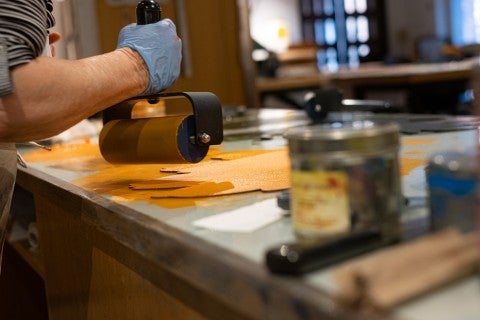Degree(s): BA, Rice University, 1982; BArch, Rice Univerity, 1984
VADA Concentration: Studio
Rice Graduation Year: 1984
Satisfaction is completing a painting that takes you to a new place. Every move becomes italized, accentuated, saturated with intention and experience. A rush can seem like slow motion. My paintings are my characters that I inhabit and make real. I am always there beside them. The synthesis of these two related entities is the result. Motivated by his parents’ warnings about the difficulties of making it as an artist, Burton devoted his college education to the study of architecture. He spent two years in the architecture program at Auburn University before transferring to Rice in 1980. Burton made the most of his time at Rice and in Houston. He recalls his studio art, art history, and architecture classes with Karin Broker, Bill Camfield, Gordon Wittenberg, Peter Papadimitrious, Bas Poulos, and visiting professor Michael Wilford as especially formative. Broker, who invited Burton back to Rice in 1999 to lead a master printmaking workshop, recalls Burton in his student days as “an amazing draftsman” who was “so wonderful to teach.” As a transfer student, Burton lived on campus at Lovett College for only one semester and tended to spend more of his time at Will Rice with a group of “artsy” friends. Among the former members of this “little Saint Elmo’s Fire-style clique” are well-known installation artist Michael Petry ’81 and fashion designer Jim Mischka ’85 of the international sensation Badgley Mischka. In an odd coincidence, the February 2000 issue of Vogue features a photograph of art collector Yvonne Force in her home, modeling a slinky Badgley Mischka gown in front of a matching Burton painting, Itchy Landscape. Burton became involved with what was then the Rice Museum, an exhibition space initiated by consummate arts patron Dominique de Menil in what is now the Rice Media Center. As a volunteer assistant, Burton helped unpack and hang the paintings for the 1982 Yves Klein retrospective at the museum. “That was really huge for a kid who grew up in Alabama and was totally salivating over the reproductions in the book. To actually have that level of familiarity with the paintings and see people hang them and go through the whole process . . . it was so amazing and a really big thing for me, and I’m very thankful to have had that experience.” Another highlight of his Rice experience was his participation in an archaeological dig outside of Rome in a 1983 summer course taught by Walter Widrig and Philip Oliver-Smith. Though Burton professes to have always known he wanted to be an artist, he greatly values his architectural training at Rice. “The program at Rice is a great program, and they really seem to stress process. It’s something the art schools don’t teach enough, in my opinion. I think if I had to do it all over again, I wouldn’t change a thing, because my primary education was architectural and then I was studying art also. I really think my studio architecture classes taught me a lot about creativity.” Burton’s rules for living are anything but abstract: “Rebel and question every step of the way. That’s what I did. It works. And don’t let them say no. Do it your own way and define your own terms. I’ve always lived by that credo.” As one of the rare individuals who has managed to mobilize his most animating and abiding passion into a professional life that not only sustains, but stimulates, Burton’s story carries a message that he doesn’t hesitate to voice. “I’m living proof, and I’m the first one to say it: you can live off of doing what you love. It hasn’t always been easy, but it’s always been possible, and I’ve never lost sight of that.”


